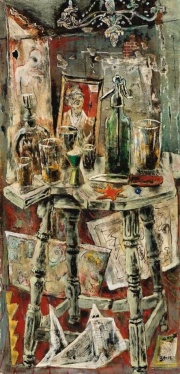Encaustic paint
Description
A paint in which dry colors are mixed with molten wax, then applied as a paint and fused to the support. Encaustic paints were most often made with Beeswax. Sometimes small amounts of natural resins, such as Dammar or Venice turpentine, were added for hardness. Oils, such as Linseed oil, were added for increased workability. Encaustic was used in classic Greek painting of the 4th and 5th centuries BCE. The paint was applied warm with a spatula or brush. It hardened quickly as it cooled to form a very durable medium. Several examples of 2nd century CE encaustic paintings on small wooden panel attached to mummy cases have been excavated from Fayum, Egypt. Encaustic was used occasionally in the 19th century for paintings (e.g., Delacroix) and interior wall decoration. It sealed cracked walls while providing a hard, washable surface.
Synonyms and Related Terms
wax paint; encaustic color; peinture à l'encaustique (Fr.); encaustica (Esp.); pintura a encáustica (Port.)
Resources and Citations
- The Dictionary of Art, Grove's Dictionaries Inc., New York, 1996 Comment: "Encaustic"
- R. J. Gettens, G.L. Stout, Painting Materials, A Short Encyclopaedia, Dover Publications, New York, 1966
- The American Heritage Dictionary or Encarta, via Microsoft Bookshelf 98, Microsoft Corp., 1998
- Reed Kay, The Painter's Guide To Studio Methods and Materials, Prentice-Hall, Inc., Englewood Cliffs, NJ, 1983
- M.Phillips, 'A Survey of Paint Technology', Paint in America, R. Moss, ed., Preservation Press, New York, 1994
- Teri Hensick, contributed information, 1998
- Art and Architecture Thesaurus Online, http://www.getty.edu/research/tools/vocabulary/aat/, J. Paul Getty Trust, Los Angeles, 2000
